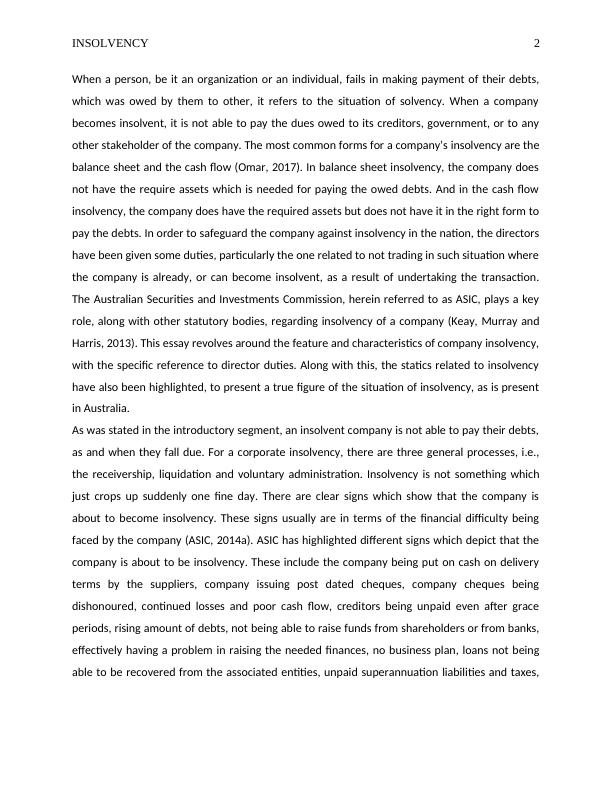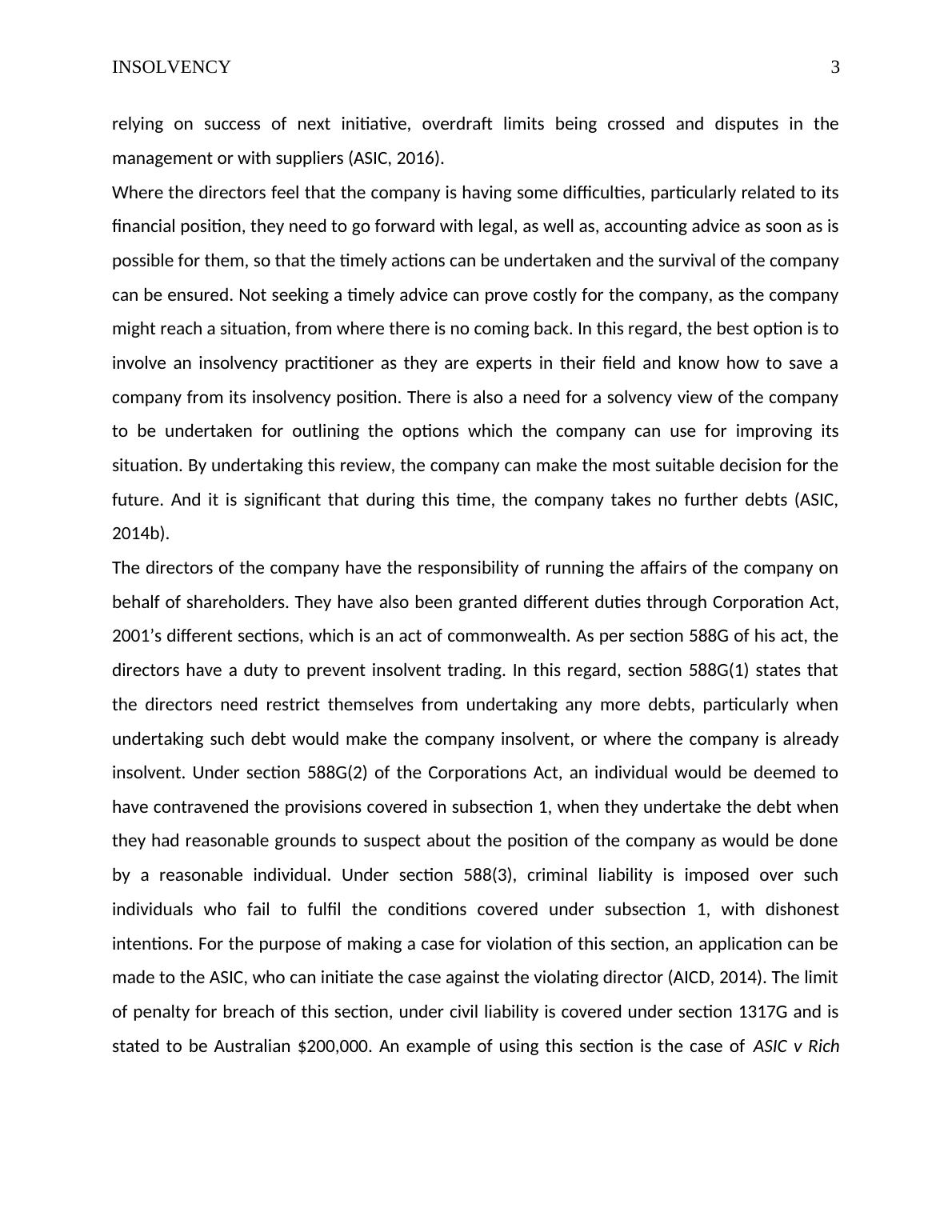Ask a question from expert
Understanding Commercial Insolvency and Corporation Law
8 Pages2887 Words249 Views
Added on 2019-10-31
Understanding Commercial Insolvency and Corporation Law
Added on 2019-10-31
BookmarkShareRelated Documents

INSOLVENCY2When a person, be it an organization or an individual, fails in making payment of their debts,which was owed by them to other, it refers to the situation of solvency. When a companybecomes insolvent, it is not able to pay the dues owed to its creditors, government, or to anyother stakeholder of the company. The most common forms for a company’s insolvency are thebalance sheet and the cash flow (Omar, 2017). In balance sheet insolvency, the company doesnot have the require assets which is needed for paying the owed debts. And in the cash flowinsolvency, the company does have the required assets but does not have it in the right form topay the debts. In order to safeguard the company against insolvency in the nation, the directorshave been given some duties, particularly the one related to not trading in such situation wherethe company is already, or can become insolvent, as a result of undertaking the transaction.The Australian Securities and Investments Commission, herein referred to as ASIC, plays a keyrole, along with other statutory bodies, regarding insolvency of a company (Keay, Murray andHarris, 2013). This essay revolves around the feature and characteristics of company insolvency,with the specific reference to director duties. Along with this, the statics related to insolvencyhave also been highlighted, to present a true figure of the situation of insolvency, as is presentin Australia. As was stated in the introductory segment, an insolvent company is not able to pay their debts,as and when they fall due. For a corporate insolvency, there are three general processes, i.e.,the receivership, liquidation and voluntary administration. Insolvency is not something whichjust crops up suddenly one fine day. There are clear signs which show that the company isabout to become insolvency. These signs usually are in terms of the financial difficulty beingfaced by the company (ASIC, 2014a). ASIC has highlighted different signs which depict that thecompany is about to be insolvency. These include the company being put on cash on deliveryterms by the suppliers, company issuing post dated cheques, company cheques beingdishonoured, continued losses and poor cash flow, creditors being unpaid even after graceperiods, rising amount of debts, not being able to raise funds from shareholders or from banks,effectively having a problem in raising the needed finances, no business plan, loans not beingable to be recovered from the associated entities, unpaid superannuation liabilities and taxes,

INSOLVENCY3relying on success of next initiative, overdraft limits being crossed and disputes in themanagement or with suppliers (ASIC, 2016).Where the directors feel that the company is having some difficulties, particularly related to itsfinancial position, they need to go forward with legal, as well as, accounting advice as soon as ispossible for them, so that the timely actions can be undertaken and the survival of the companycan be ensured. Not seeking a timely advice can prove costly for the company, as the companymight reach a situation, from where there is no coming back. In this regard, the best option is toinvolve an insolvency practitioner as they are experts in their field and know how to save acompany from its insolvency position. There is also a need for a solvency view of the companyto be undertaken for outlining the options which the company can use for improving itssituation. By undertaking this review, the company can make the most suitable decision for thefuture. And it is significant that during this time, the company takes no further debts (ASIC,2014b).The directors of the company have the responsibility of running the affairs of the company onbehalf of shareholders. They have also been granted different duties through Corporation Act,2001’s different sections, which is an act of commonwealth. As per section 588G of his act, thedirectors have a duty to prevent insolvent trading. In this regard, section 588G(1) states thatthe directors need restrict themselves from undertaking any more debts, particularly whenundertaking such debt would make the company insolvent, or where the company is alreadyinsolvent. Under section 588G(2) of the Corporations Act, an individual would be deemed tohave contravened the provisions covered in subsection 1, when they undertake the debt whenthey had reasonable grounds to suspect about the position of the company as would be doneby a reasonable individual. Under section 588(3), criminal liability is imposed over suchindividuals who fail to fulfil the conditions covered under subsection 1, with dishonestintentions. For the purpose of making a case for violation of this section, an application can bemade to the ASIC, who can initiate the case against the violating director (AICD, 2014). The limitof penalty for breach of this section, under civil liability is covered under section 1317G and isstated to be Australian $200,000. An example of using this section is the case of ASIC v Rich

End of preview
Want to access all the pages? Upload your documents or become a member.
Related Documents
CLAW314, Essay on Insolvency of a Companylg...
|11
|2861
|646
Corporate Law Instructors Name Institution Supervisors Name Course Introductionlg...
|23
|3263
|116
Assignment Of LAW | Insolvency Consideration - LG237lg...
|11
|2559
|90
Corporate Insolvency in Australialg...
|11
|2588
|91
Paper on Company’s Insolvencylg...
|11
|2500
|115
Essay on Insolvency in Lawlg...
|11
|2330
|279